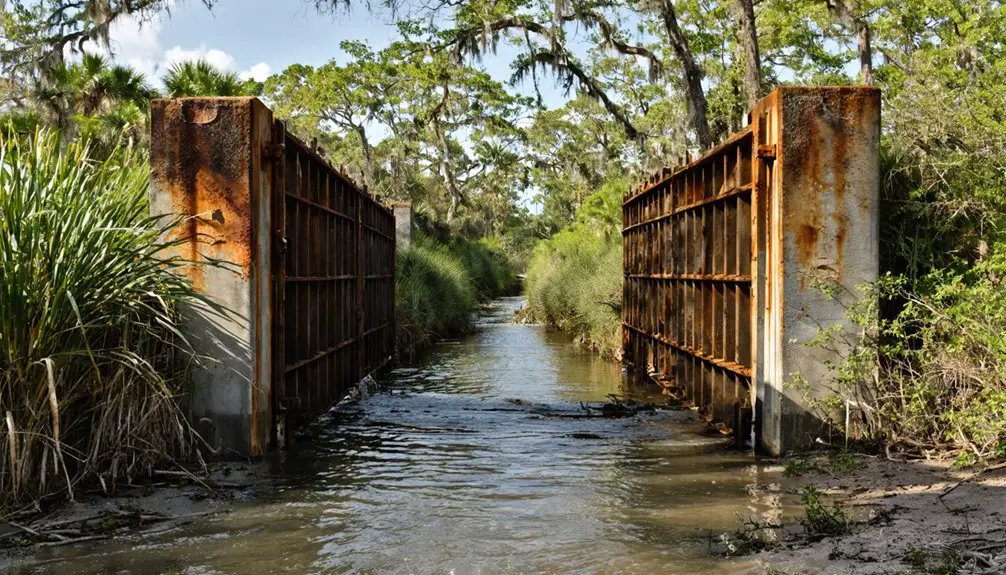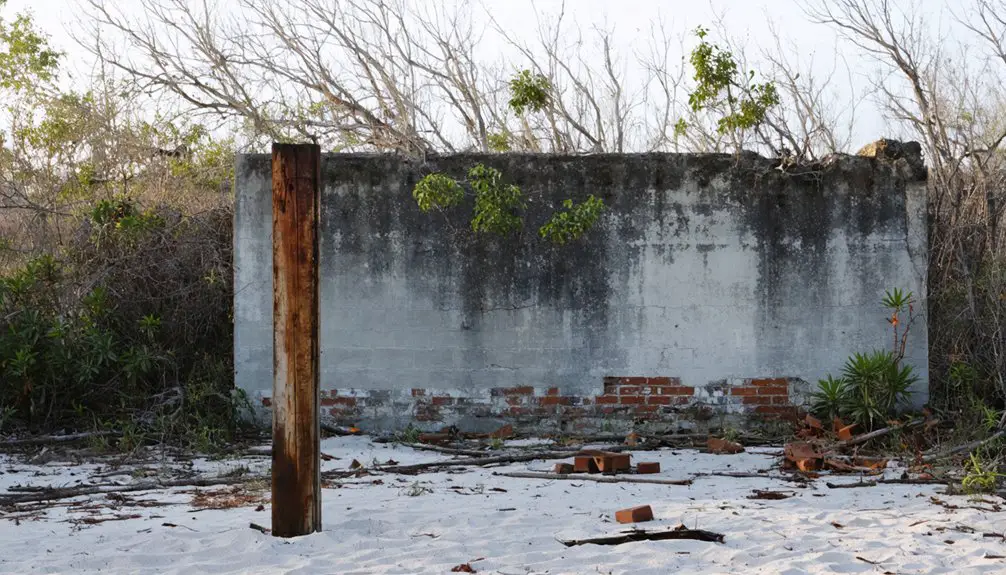You’ll find Tillman’s ghost town roots in 1880s Palm Bay, Florida, where John Tillman established a bustling steamboat stop and agricultural settlement along Turkey Creek. The community thrived with German and Slavic farmers through the Indian River Catholic Colony until the 1920s, when an ambitious drainage project, natural disasters, and the Great Depression led to its decline. While few original structures remain, the Melbourne-Tillman Canal system and local place names preserve the settlement’s fascinating story.
Key Takeaways
- Tillman was established in the 1880s as an agricultural settlement along Turkey Creek but later declined into abandonment.
- The community’s ambitious drainage project in 1922 failed after the Great Depression and a devastating 1926 hurricane.
- Originally home to German and Slavic farmers through the Florida Indian River Catholic Colony, most settlers eventually left.
- Few original structures remain today, though the Melbourne-Tillman Canal system serves as a reminder of the settlement.
- The area was absorbed into modern Palm Bay, with only historical markers and place names preserving Tillman’s legacy.
The Birth of a Settlement: From Native Lands to Steamboat Stop
Before becoming the bustling steamboat stop of the 1880s, the land that would become Tillman served as home to the Timucua Indians, who thrived along Turkey Creek‘s fertile shores.
You’ll find their legacy in the abundant natural resources they relied on for native sustenance – from the fish and oysters in the creek to the diverse wildlife in the surrounding wetlands.
The area’s transformation began when John Tillman established his settlement in the 1880s, developing banana and citrus groves along the waterfront.
John Tillman’s vision transformed untamed wilderness into a flourishing settlement, where citrus and banana groves stretched across the pristine waterfront.
His strategic placement of a wharf at Turkey Creek’s mouth proved essential for early settlement success, creating a significant steamboat stop along the Indian River.
The wharf quickly became a hub for commerce, connecting Tillman’s agricultural bounty to broader markets and establishing the foundation for a thriving community.
In the early 1900s, the area attracted German and Slavic farmers through the Florida Indian River Catholic Colony, though their settlement hopes were short-lived.
The settlement later evolved to include lumber operations as European settlers arrived seeking new economic opportunities.
Agriculture’s Rise and Fall: The Catholic Colony Era
While Tillman’s early settlers had established modest agricultural success, the area underwent a dramatic transformation between 1910 and 1914 when a land development company recruited 105 German and Czech Catholic families from the Midwest to establish the Indian River Catholic Colony.
John Tillman, one of the first white settlers, had initially shown agricultural potential by cultivating banana and orange groves in the 1870s.
The settlers’ ambitious plans included growing two crops per season, but their lack of proper soil management quickly led to nutrient depletion.
Despite building St. Joseph’s Church and establishing a vibrant community centered around the Slama Hotel, the colony’s agricultural dreams crumbled. The area’s development took a new direction when the Melbourne-Tillman Drainage District was established in the 1920s to manage water flow.
Transformation Through Drainage: The Melbourne-Tillman Project

Following the decline of the Catholic Colony, a major engineering initiative transformed Tillman’s landscape and economic prospects. In 1922, the Melbourne-Tillman Drainage District launched a $1.5 million project that would dramatically reshape the region’s hydrological landscape.
The drainage impact was extensive, with engineers constructing:
The ambitious drainage project reshaped the region through an intricate network of canals, dikes, and waterways, transforming wetlands into usable land.
- 180 miles of interconnected canals in a precise grid pattern
- A 22-mile protective dike along western and southern boundaries
- Major waterways including Tillman and Hopkins canals
- Infrastructure supporting 40,000 acres of reclaimed marshland
These hydrological changes converted swampland into productive agricultural terrain, sparking economic growth through cattle ranching, citrus cultivation, and truck farming. This area would later become part of what modern maps identify as Palm Bay locations.
However, the project’s promise was short-lived. The Great Depression, combined with a devastating 1926 hurricane and fire, ultimately led to the drainage district’s bankruptcy, leaving the ambitious transformation incomplete at 85% completion.
Natural Disasters and Economic Decline
Natural disasters struck repeated blows to Tillman’s survival throughout the 20th and 21st centuries.
You’ll find the community was particularly vulnerable to devastating hurricanes like Wilma and Ian, which brought storm surges of 5-10 feet and rainfall exceeding 20 inches.
These storms’ hurricane impacts went far beyond immediate destruction – they triggered prolonged power outages, contaminated water supplies, and destroyed essential infrastructure.
The 2004 hurricane season devastated over 20% of houses in the region, dealing a severe blow to Tillman’s already fragile economy.
The mounting costs of recovery proved insurmountable for this small town.
With each disaster, economic recovery became harder as insurance premiums skyrocketed and property values plummeted.
Residents gradually abandoned their homes and businesses, unable to shoulder the financial burden of repeated rebuilding.
The cycle of destruction ultimately transformed Tillman from a living community into a ghost town, crushed under the weight of Florida’s unforgiving weather patterns.
Legacy and Remnants of Old Tillman
The remnants of old Tillman paint a sparse portrait of this once-thriving pioneer settlement.
You’ll find its historical significance woven into the fabric of modern Palm Bay, though few physical structures remain to tell its story.
Much like Fort Dade’s brick road, remnants of early transportation infrastructure can still be traced in the area today.
Similar to the great freeze that devastated Kerr City, harsh weather events challenged early Tillman settlers.
The community identity lives on through:
Though the buildings are gone, Tillman’s spirit echoes through place names, waterways, and agricultural footprints across modern Palm Bay.
- The Melbourne-Tillman Canal system, a reflection of 1920s agricultural drainage projects
- Local place names that preserve the memory of founder John Tillman
- The original wharf location where steamboats once docked along Turkey Creek
- Agricultural patterns visible in the landscape from early citrus and banana cultivation
While you won’t find standing buildings from the original settlement, Tillman’s legacy endures in the region’s development patterns.
From its 1880s founding to its 1925 shift to Palm Bay, the ghost town represents an important chapter in Florida’s pioneer history.
Frequently Asked Questions
Are There Any Remaining Structures From the Original Tillman Settlement?
You won’t find any remaining buildings from the original settlement today. Historical preservation wasn’t prioritized, and Palm Bay’s rapid development, combined with natural disasters, eliminated all physical traces of Tillman’s structures.
What Happened to the Descendants of John Tillman?
You’ll find John Tillman’s descendants likely dispersed across Ohio, Tennessee, and Virginia following economic hardships and natural disasters in Florida, with no records showing continued family presence in Palm Bay after 1928.
How Did Local Native American Tribes React to European Settlement?
You’ll find the native tribes initially established trade relationships with Europeans but faced devastating cultural displacement through disease, warfare, and raids that nearly destroyed their societies by the early 1700s.
Where Exactly Was the Steamboat Wharf Located?
You’ll find the magnificent steamboat wharf’s historical location at Turkey Creek’s north shore where it meets the Indian River Lagoon, near today’s Castaway Point in Palm Bay, Florida.
Did Any Industries Besides Agriculture Succeed in Early Tillman?
You’ll find limited evidence of successful non-agricultural industries in Tillman, though shipping, modest tourism services, and possibly small-scale timber industry and fishing ventures operated alongside farming before the town’s decline.
References
- https://businessviewmagazine.com/palm-bay-florida-city-on-a-roll/
- https://www.florida-backroads-travel.com/palm-bay-florida.html
- https://palmbayflorida.weebly.com
- https://melbourneproperties.com/palm_bay_real_estate.htm
- https://businessviewmagazine.com/palm-bay-florida-moving-ahead/
- https://frontier-florida.blogspot.com/2014/11/utopia-it-wasnt.html
- https://frontier-florida.blogspot.com/2014/11/
- https://brevardfl.gov/docs/default-source/historical-commission-docs/not-508-historical-landmarks/2016-brevard-county-landmark-guide.pdf?sfvrsn=8b794af4_6
- https://www.ghosttowns.com/states/fl/tillman.html
- https://en.wikipedia.org/wiki/Palm_Bay



